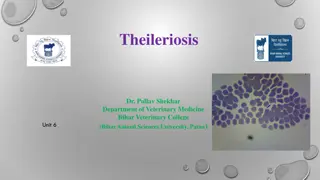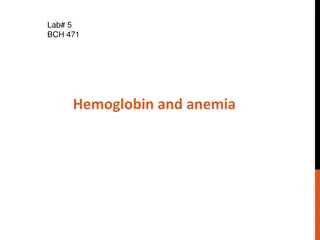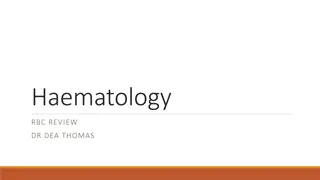Perioperative Patient Blood Management
The Patient Blood Management (PBM) Program implemented by Orthopaedic Surgeon Daryl Teague to provide optimal care for Ruby, a 73-year-old with diabetes and high blood pressure, who needs a new hip joint. The program includes preoperative anemia assessment, intraoperative blood conservation, and pos
2 views • 20 slides
Understanding Hemoglobin: Functions, Medical Applications, and Conditions
Hemoglobin, a crucial protein in red blood cells, plays a vital role in carrying oxygen throughout the body. This article delves into its functions, detection methods, medical applications, and common conditions associated with hemoglobin, such as anemia and polycythemia. Learn about the various typ
4 views • 16 slides
Advancements in Regenerative Medicine for Sickle Cell Anemia
Regenerative medicine holds promise for treating sickle cell anemia through techniques like stem cell transplantation. This approach targets genetic blood diseases, offering potential cures beyond traditional uses like eradicating cancer. Despite obstacles like toxicity and donor availability, innov
8 views • 26 slides
Introduction to Haematopathology - Understanding Blood Cell Disorders
Haematopathology is the study of diseases related to blood cells and their production. This branch of pathology delves into haemopoiesis, normal blood constituents, anemia, polycythemia, and more. Learn about erythropoiesis, different blood cell types, erythropoietin, haemoglobin, and disorders like
1 views • 31 slides
Addressing Anemia Among Pregnant Women in Meerut District
Anemia is a prevalent condition among pregnant women in Meerut, India. The Anemia Mukt Bharat program aims to reduce anemia rates by providing iron and folic acid supplements through ANC services. Data analysis shows progress in ANC registration and iron tablet consumption, highlighting the importan
0 views • 11 slides
Understanding Clinical Features of Anemia
Clinical features of anemia include cardiovascular adaptations, variations in symptom presentation based on speed and severity of onset, implications of age, and changes in the hemoglobin-O2 dissociation curve. Symptoms may range from breathlessness and weakness to cardiac issues, while signs like p
0 views • 28 slides
Understanding Red Blood Cell Abnormalities in Anemia: A Detailed Overview
This in-depth article delves into the various types of red blood cell abnormalities seen in anemia, such as anisocytosis, poikilocytosis, spherocytes, ovalocytes, acanthocytes, codocytes, drepanocytes, and stomatocytes. It explains the characteristics of each abnormality, their significance in diffe
0 views • 45 slides
Understanding Bovine Theileriosis: Causes, Symptoms, and Prevention
Bovine theileriosis is a tick-borne haemoprotozoan disease that causes significant economic losses in livestock due to high mortality rates, weight loss, abortion, and reduced milk yield. The disease is characterized by fever, anemia, and respiratory and digestive disorders. It is caused by parasite
1 views • 11 slides
Understanding Anemia: Causes, Mechanisms, and Classifications
Anemia is a condition characterized by a deficiency in red blood cells or their oxygen-carrying capacity, impacting physiological needs. Causes include blood loss, decreased production, and destruction of red blood cells. There are various classifications such as acute and chronic blood loss anemia,
0 views • 19 slides
Automated Melanoma Detection Using Convolutional Neural Network
Melanoma, a type of skin cancer, can be life-threatening if not diagnosed early. This study presented at the IEEE EMBC conference focuses on using a convolutional neural network for automated detection of melanoma lesions in clinical images. The importance of early detection is highlighted, as exper
0 views • 34 slides
Anemia in Swine: Causes, Clinical Signs, and Treatment
Anemia in swine can be caused by factors such as gastric ulcers, internal bleeding, and poor nutrition. Clinical signs include pale skin, rapid breathing, and jaundice. Piglet anemia, a highly fatal disease, is marked by decreased hemoglobin levels and liver degeneration. Diagnosis involves examinin
0 views • 11 slides
Understanding Hemoglobin: Synthesis, Functions, and Influence on Anemia
Hemoglobin is a vital protein in red blood cells responsible for oxygen transport. Its synthesis, influenced by factors like erythropoietin, vitamins, and trace metals, plays a crucial role in maintaining proper oxygen levels in the body. An insight into hemoglobin's structure, synthesis, and impact
3 views • 19 slides
Urinary Tract Infections and Anemia in Pregnancy: Overview and Management
This course discusses the common medical complications of urinary tract infections and anemia in pregnancy, including types of UTI recurrences, pathophysiology, common causative organisms, anatomical changes in pregnancy leading to increased risk, risk factors for UTIs in pregnancy, and more.
0 views • 26 slides
Iron Deficiency Anemia in a 78-Year-Old Man: A Case Study
A 78-year-old man presents with symptoms of fatigue, headache, and abdominal pain, leading to a diagnosis of iron deficiency anemia. His medical history includes hypertension, type II diabetes, and chronic shoulder pain. Investigations reveal hypochromic, microcytic anemia with low iron levels and h
0 views • 117 slides
Colorimetric Detection of Hydrogen Peroxide Using Magnetic Rod-Based Metal-Organic Framework Composites
Nanomaterials, particularly magnetic rod-based metal-organic frameworks composites, are gaining attention for their exceptional properties and various applications in different fields. This study by Benjamin Edem Meteku focuses on using these composites for colorimetric detection of hydrogen peroxid
0 views • 16 slides
Understanding Hemolytic Anemia: Classification and Management
Hemolytic anemia encompasses various subtypes like autoimmune hemolytic anemia, with warm and cold antibodies, each requiring unique management strategies. Diagnosis involves specific investigations like the Coombs test. Treatment typically involves corticosteroids as first-line therapy, while secon
1 views • 23 slides
Global Chemotherapy Induced Anemia Market
The Global Chemotherapy Induced Anemia Market Size is expected to reach USD 3.99 billion by 2030, at a CAGR of 7.2% during the forecast period 2021 to 2030.\n
1 views • 4 slides
Understanding Hypochromic Anemias: Background, Diagnosis, and Key Findings
Anemia is characterized by a decrease in hemoglobin levels below normal, leading to various symptoms and signs. This article explores the background, definition, and causes of hypochromic anemias, along with a diagnostic algorithm and key laboratory findings essential for diagnosis. Clinical feature
1 views • 26 slides
Understanding Anemia: Key Concepts and Clinical Features
Anemia is a common condition characterized by a reduction in hemoglobin levels, leading to decreased oxygen-carrying capacity in the blood. This article delves into important aspects such as hematopoiesis, erythropoiesis, hemoglobin synthesis, and clinical manifestations of anemia. Learn about the s
0 views • 18 slides
Comprehensive Algorithms for Cytogenomic Testing in Hematologic Malignancies
This document outlines clinical algorithms for the genetic evaluation of chronic lymphocytic leukemia (CLL), myelodysplastic syndromes (MDS), aplastic anemia, and idiopathic acquired aplastic anemia. It provides detailed protocols for genetic testing, including SNP array karyotyping, cytogenetic and
0 views • 8 slides
Understanding Anemia: Causes, Symptoms, and Classification
Anemia is characterized by a reduction in hemoglobin (Hg) concentration, hematocrit (Hct) concentration, or red blood cell (RBC) count. Common symptoms include fatigue, weakness, dizziness, and palpitations. Physical signs may include pallor and tachycardia. Pica, characterized by unusual cravings,
0 views • 23 slides
Overview of GRANDproto Project Workshop on Autonomous Radio Detection
GRANDproto project workshop held in May 2017 focused on improving autonomous radio detection efficiency for the detection of extensive air showers (EAS). Issues such as detector stability and background rates were discussed, with the goal of establishing radio detection as a reliable method for EAS
1 views • 14 slides
Timely Leak Detection San Diego | Professional Leak Detection Services
Protect your home with expert leak detection services in San Diego. Avoid costly water damage and health risks with timely detection of hidden leaks. Schedule today!\n\nKnow more: \/\/ \/san-diego-slab-leak-detection\/
0 views • 7 slides
How Professional Leak Detection Can Save Your San Diego Home | Leak Detection Sa
Protect your home from costly damage with professional leak detection in San Diego. Learn about expert services like slab leak detection, non-invasive testing, and more. Save money and prevent water damage with top San Diego leak detection services.\
0 views • 8 slides
Understanding Haemonchosis in Small Ruminants
Haemonchosis is a significant disease affecting sheep and goats that is caused by blood-sucking parasites. This condition leads to anemia, debility, and pain in infected animals. The etiology involves various species of Haemonchus affecting different animals. Understanding the life cycle, characteri
0 views • 23 slides
Understanding Sickle Cell Anemia: Causes, Symptoms, and Pathophysiology
Sickle cell anemia is an inherited disorder affecting red blood cells' shape, leading to decreased oxygen delivery and various symptoms like fatigue, pain episodes, and more. The condition arises from a genetic mutation affecting hemoglobin production. Individuals with sickle cell trait may not disp
0 views • 7 slides
Understanding Intrusion Detection Systems (IDS) and Snort in Network Security
Intrusion Detection Systems (IDS) play a crucial role in network security by analyzing traffic patterns and detecting anomalous behavior to send alerts. This summary covers the basics of IDS, differences between IDS and IPS, types of IDS (host-based and network-based), and the capabilities of Snort,
0 views • 34 slides
Individualized Medicine and Biophysical System Dynamics in End-Stage Renal Disease
This presentation delves into the management of anemia in dialysis patients using system dynamics modeling, particularly at Mayo Clinic. Chronic kidney disease, hemodialysis, anemia, and the significance of erythropoietic stimulating agents are discussed. Anemia poses a key quality of life issue for
0 views • 26 slides
District Assessment Tool for Anemia (DATA) Overview
This presentation highlights the development and purpose of the District Assessment Tool for Anemia (DATA), emphasizing its role in addressing anemia as a multi-sectoral issue at the district level. The tool aims to assist stakeholders in identifying gaps, enablers, and barriers to tackling anemia r
0 views • 20 slides
National Deworming Day 10 August 2018 - Importance, Benefits, and Process
National Deworming Day on 10 August 2018 aims to deworm all children using albendazole chewable tablets to combat intestinal worms, which can cause anemia and other health issues. In cases where children could not be dewormed on the designated day, a mop-up day on 17 August is scheduled. Deworming h
0 views • 5 slides
Correlation Study of Low Birth Weight, Anemia, and Family Involvement in Antenatal Care
The study examines the relationship between family involvement in antenatal care, anemia, and low birth weight based on statistics from a Health Promoting Hospital in 2013. Analysis shows significant correlations between family involvement, anemia, and low birth weight, highlighting the importance o
0 views • 24 slides
Understanding Anomaly Detection in Data Mining
Anomaly detection is a crucial aspect of data mining, involving the identification of data points significantly different from the rest. This process is essential in various fields, as anomalies can indicate important insights or errors in the data. The content covers the characteristics of anomaly
0 views • 50 slides
Understanding G6PD Deficiency Hemolytic Anemia: Biochemical Basis and Implications
G6PD deficiency hemolytic anemia is an inherited condition characterized by reduced levels of glucose-6-phosphate dehydrogenase (G6PD), leading to impaired production of NADPH. This deficiency affects the Pentose Phosphate Pathway (PPP) and can result in oxidative stress, causing damage to DNA, prot
0 views • 18 slides
Understanding Anemia: Causes, Symptoms, and Diagnosis
Anemia is a condition characterized by low red blood cell count, leading to symptoms like fatigue, pale skin, and shortness of breath. Causes range from nutritional deficiencies to chronic diseases. Diagnosis involves blood tests and examination of red blood cells. This content delves into various t
0 views • 52 slides
Understanding Anemia: Causes, Types, and Impact on Indian Population
Anemia is a serious health condition characterized by low hemoglobin levels, leading to reduced oxygen supply to the body. This article delves into the definition of anemia, its types - including genetic and nutritional anemia, and highlights the significant prevalence of anemia in India, especially
0 views • 16 slides
Object Detection Techniques Overview
Object detection techniques employ cascades, Haar-like features, integral images, feature selection with Adaboost, and statistical modeling for efficient and accurate detection. The Viola-Jones algorithm, Dalal-Triggs method, deformable models, and deep learning approaches are prominent in this fiel
0 views • 21 slides
Anemia in Pregnancy: Types, Etiology, and Management
Dr. Methal A. Alrubaie, an assistant professor, presents a detailed overview of anemia in pregnancy. The content covers the classification of anemia types, their etiology, clinical presentation, effects on both mother and fetus, investigation methods, and treatment approaches. Various types of anemi
0 views • 19 slides
Understanding Anemia: Causes, Types, and Prevention
Anemia occurs when there are not enough red blood cells in the body, leading to symptoms like fatigue, rapid heartbeat, and pale skin. Causes include nutrient deficiencies, interfering substances, and poor environmental conditions. Different types of anemia such as hypochromic, megaloblastic, and di
0 views • 17 slides
Sickle cell Anemia treatment in India for African Children
Sickle Cell Treatment in India for African Children\nSickle Cell Anemia or Sickle Cell Disease is very common in Sub-Saharan African countries. The demographic prevalence of Sickle cell anemia can be gauged from the following acknowledged numbers of
1 views • 3 slides







































